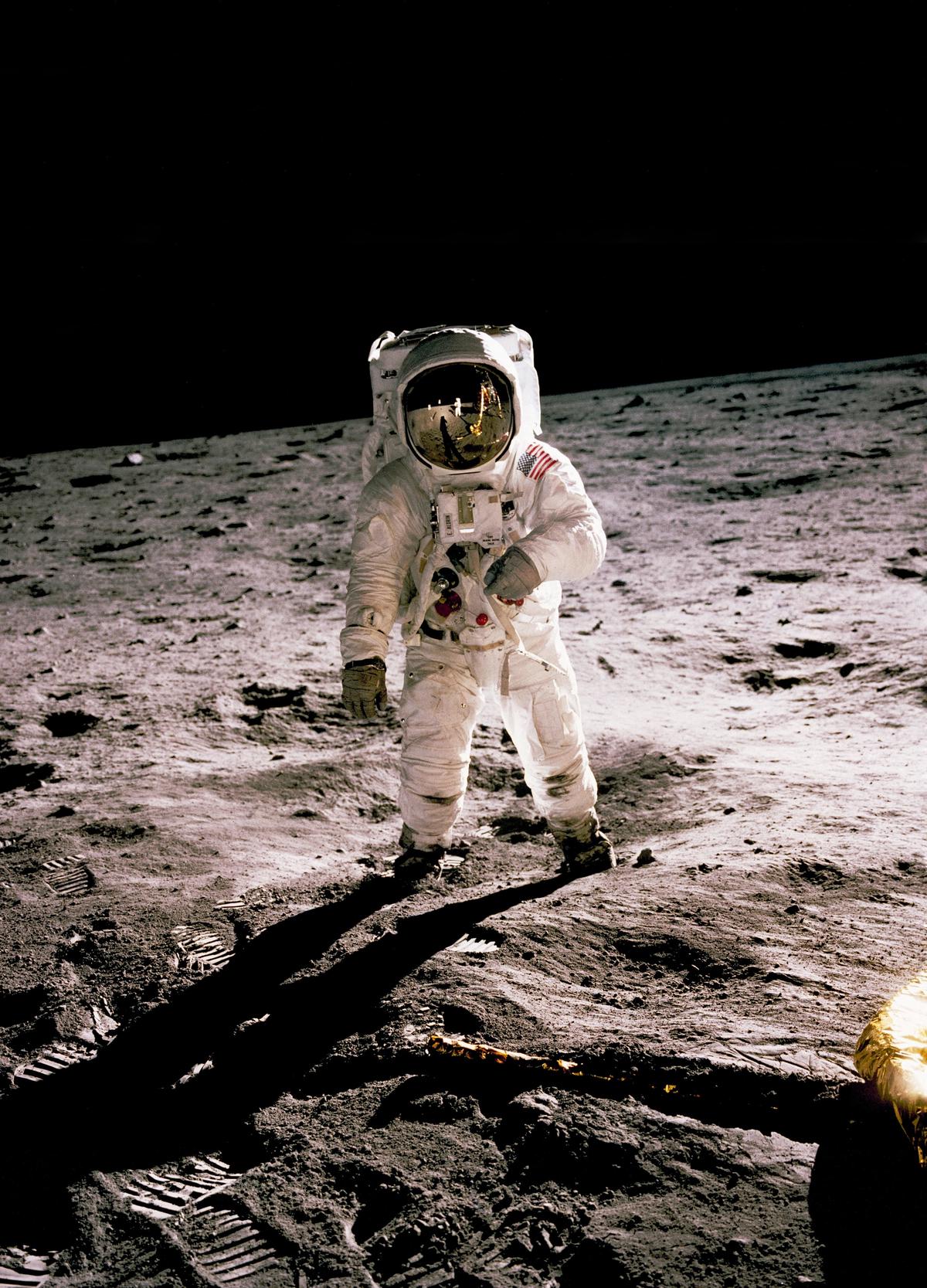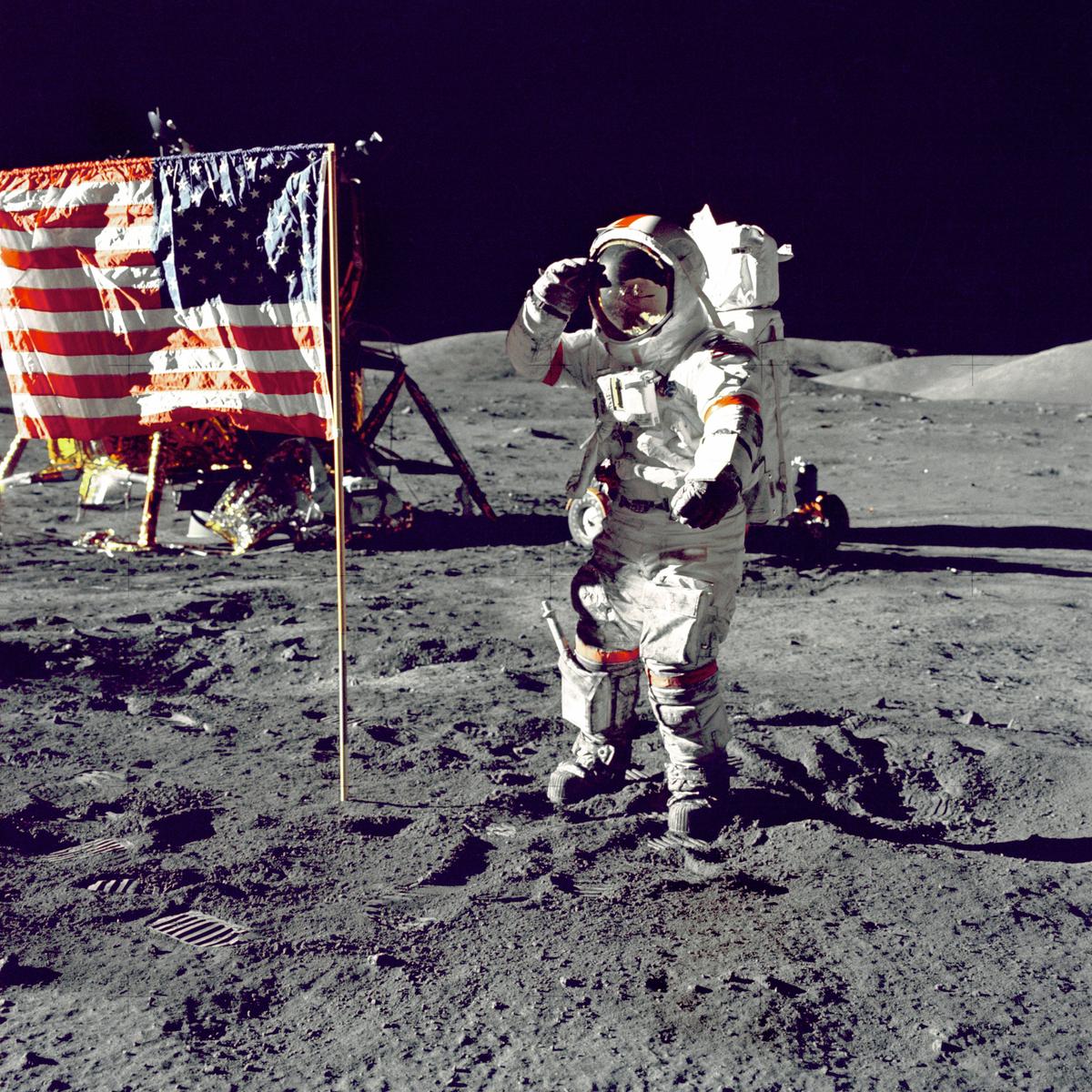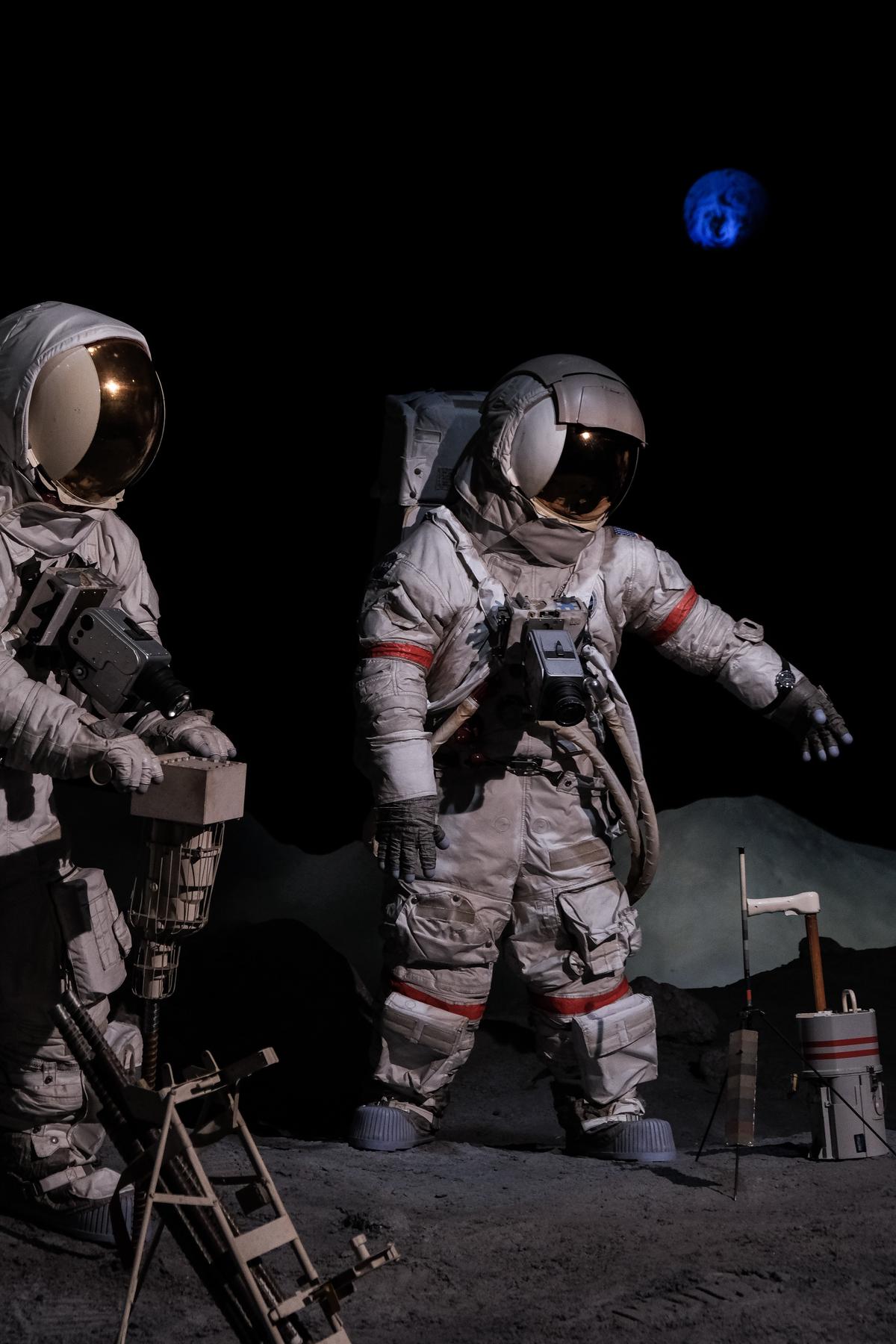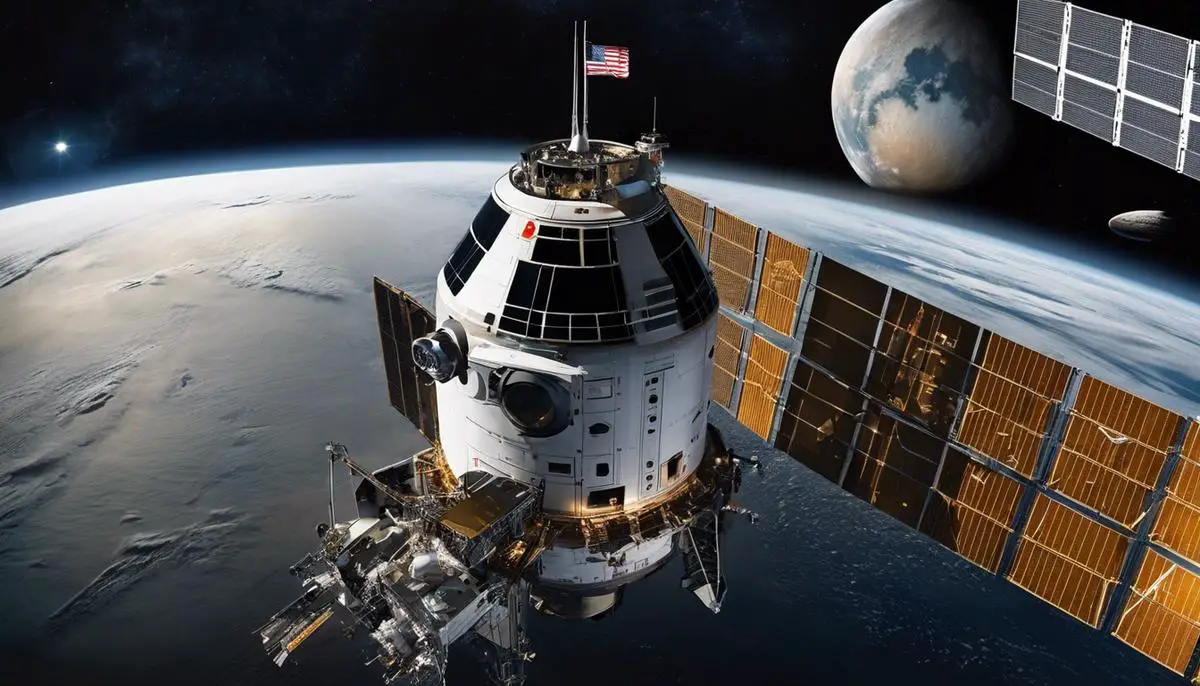When humanity cast its gaze skyward to the glimmering surface of the Moon, a dream was born—one that took form through the extraordinary efforts of the Apollo space program. Embarking on a journey that would redefine our place in the cosmos, Apollo was a beacon of exploration, igniting technological innovations that today still echo across the expanses of time and space. With the mighty roar of the Saturn V rocket, a symphony of engineering marvels, scientific insights, and human courage marked the path to our celestial neighbor. As we delve into the fabric of this historic odyssey, we unravel the rich tapestry of achievements—from the labyrinthine circuitry of pioneering computers to the rugged terrain of the lunar surface, and from the vast, silent vacuum traversed by astronauts to the indelible images that would forever alter our collective consciousness.
Technological Innovations of Apollo
The Indelible Legacy of the Apollo Program on Space Technology
The Apollo program, conceptualized and executed by the National Aeronautics and Space Administration (NASA) from 1961 to 1972, remains one of the most audacious and triumphant human undertakings in the pursuit of space exploration. At the heart of the program was a series of missions with the aim of landing humans on the Moon and ensuring their safe return to Earth. The technological advances and the profound impact of the Apollo missions continue to resonate within the aerospace community, characterizing a watershed moment in human history.
One must recognize the formidable challenges overcome by Apollo, which immediately precipitated a surge in innovation. The development of the Saturn V launch vehicle, to date the most powerful rocket ever built, was an exercise in overcoming the limits of existing propulsion technology. The F-1 engines that powered the Saturn V stand as a testament to the progress in rocketry, seamlessly integrating advances in materials science and engineering acumen.
Furthermore, the Apollo Guidance Computer inaugurated a new era in navigation and on-board computing. The utilization of integrated circuits was a pioneering step, catalyzing the miniaturization of electronics. Although primitive by contemporary standards, this computer enabled precise guidance and control for the lunar landing, an application with appreciable pertinence to modern spaceflight and terrestrial navigational systems.
Lunar exploration necessitated the evolution of spacecraft design. The Lunar Excursion Module (LEM), a marvel of engineering, for the first time realized a controlled landing on an extraterrestrial surface. The ingenuity of the LEM’s life-support systems, propulsion, and modular design informs current space habitat and vehicle development projects.
The need for reliable communication systems led to advancements in telecommunications. High-gain antennas and tracking stations deployed as part of the Manned Space Flight Network (MSFN) ensured robust communication and telemetry. This infrastructure underscored the importance of global cooperation in space exploration and heightened the sophistication of satellite communication systems.
Beyond hardware, Apollo demanded advancements in extravehicular activity (EVA) technologies. The development of the A7L spacesuit, boasting thermal, micrometeoroid and pressure protection, greatly influenced subsequent EVA suit designs. Moreover, the inherent risk management and operational protocols established during Apollo have percolated through subsequent space missions, heightening the safety and efficiency of extravehicular endeavors.
The scientific instruments carried and left on the lunar surface by Apollo missions have delivered invaluable data, prompting significant insight into lunar geology and solar physics. These instruments, such as the Lunar Seismometers and the Solar Wind Spectrometer, laid the foundation for sophisticated remote scientific analysis and instruments operating on current space missions.
In the broader societal sense, Apollo has inextricably linked science education and inspiration. The awe engendered by the lunar missions has fueled generations of scientists and engineers, further propelling space technology and research.
In sum, the Apollo program catalyzed a dramatic expansion of technological capabilities, many of which have permeated other sectors, benefitting not just space exploration but also the modern technological landscape at large. As humanity gazes towards the cosmos with aspirations of Mars colonization and deep space exploration, it is incumbent upon us to acknowledge the conceptual and practical foundation laid by the Apollo program – a blueprint of human ingenuity and daring that remains unrivaled in the annals of space exploration.

Scientific Discoveries and Lunar Studies
Beyond the indelible mark left upon technology and society, the Apollo lunar missions contributed immensely to our scientific understanding of the Moon, and by extension, the origins of Earth and the celestial mechanisms at play within our solar system. This article will delve into the pivotal scientific knowledge accrued from these historic space explorations.
The collection and analysis of lunar material have been particularly insightful. The Apollo astronauts successfully returned a total of 382 kilograms of rocks, core samples, and lunar dust. Laboratory examinations of these materials have illuminated the Moon’s geological history. It has been established that significant volcanic activity occurred on the Moon about 3 to 4 billion years ago, and through radiometric dating of the samples, the lunar surface has been aged at 4.5 billion years old, which approximates the age of the solar system, offering insight into the early environmental conditions of Earth’s formation.
Lunar geology has further confirmed the hypothesis of lunar origin through the giant impact theory, which postulates that the Moon was created from the debris left over after a Mars-sized body collided with Earth. The isotopic similarities between Earth rocks and lunar samples are consistent with this theory, adding considerable weight to this model of the Moon’s genesis.
The geophysical experiments left behind by astronauts—namely the Lunar seismometers which are part of the Apollo Lunar Surface Experiments Package (ALSEP)—have recorded moonquakes, providing data about the Moon’s interior. The Moon was discovered to have a thin crust, a small core, and to be geologically active, albeit less so than Earth. The seismometers also recorded the impact of meteoroids, contributing to understanding lunar impact rates and, by extrapolation, the impact history in the inner solar system.
Further, retroreflectors placed on the lunar surface enable very precise measurements of the Earth-Moon distance through lunar laser ranging experiments. This has advanced our grasp of the dynamics of the Earth-Moon system, including the gradual increase in the Earth-Moon distance and the slowing down of Earth’s rotation. This knowledge contributed to our understanding of tidal forces and has influenced the knowledge in gravitational theories including General Relativity.
From an astronomical perspective, the absence of an atmosphere on the Moon facilitated unobscured measurements of the solar wind. Solar wind composition experiments deployed by Apollo astronauts have provided details about this stream of charged particles radiating from the sun, giving significant insight into solar processes and the influence of solar wind on planetary bodies without magnetic fields.
Last but not least, through in-situ observations and measurements, the Apollo missions have furnished vital data on the space environment, such as radiation levels on the lunar surface. This information is not just historical; it is critical for planning future human and robotic exploration missions to the Moon, Mars, and beyond, enabling the formulation of adequate protection strategies against cosmic radiation.
In conclusion, the scientific knowledge procured from the Apollo missions has reshaped our understanding of lunar and planetary science, geophysics, and astronomy. It serves as a reminder that human curiosity, when coupled with the pursuit of exploration, can unravel the mysteries of our natural world, enriching our comprehension of the very fabric of the universe.

Photo by historyhd on Unsplash
Human Spaceflight and Its Challenges
Efficient Navigation and Precision Landing on a Celestial Body
Ensuring a precise and secure landing on the moon’s surface was one of the formidable challenges addressed by the Apollo program. The unpredictable topography and largely unknown properties of the lunar surface necessitated innovative solutions for navigation and landing sequences. The intersection of inertial navigation systems, star-based guidance, and radar technologies culminated in a capability to execute landings with extraordinary accuracy within the constraints of 1960s technology.
Lunar Dust: A Pervasive and Perplexing Adversary
The presence of lunar regolith, commonly referred to as lunar dust, posed an unexpected and multifaceted obstacle to the operational integrity of both equipment and astronauts. Its highly abrasive nature led to wear and damage on seals and moving parts of equipment. Moreover, its adherence to surfaces due to van der Waals forces presented significant challenges for thermal control and the integrity of various materials. The mitigation of these issues was crucial to the success of extravehicular operations on the lunar surface and remains a topic of active research for future missions.
Human Factors: from Earth to the Lunar Realm
The field of space medicine had to evolve rapidly to meet the demands of extended human presence both in transit to the moon and on its surface. Concerns ranged from the effects of prolonged weightlessness on the human body to the provision of life support systems capable of ensuring survivability in the harsh environment of space. The development of biomedical monitoring equipment for in-flight use and protocols for maintaining astronaut health were vital.
Psychological stress, a potential detriment to mission success, was also a consideration, given the unprecedented nature of placing humans in a profoundly foreign environment far from home. The Apollo program yielded a wealth of information on the psychological resilience of astronauts and the necessity of designing missions that account for human cognitive and emotional well-being.
The Silent Sentinel: Micrometeoroid Protection
The Earth’s atmosphere provides robust protection against micrometeoroids, which disintegrate upon entry. However, the Apollo spacecraft traversed and operated in a region where such a protective shield was nonexistent. Micrometeoroid impacts posed a persistent threat capable of breaching the spacecraft hull or damaging vital systems. Innovations in material science, including multi-layer insulation and Whipple shields, were employed as countermeasures to this pervasive space hazard.
Orbital Mechanics and Return Trajectory Optimization
Achieving a successful return to Earth necessitated an exact understanding of celestial mechanics and the precise calculation of return trajectories. The Apollo missions leveraged the gravitational forces of both Earth and the moon through trans-lunar injection and trans-Earth injection maneuvers, showcasing an impressive application of astrodynamics. Ensuring the safe re-entry of astronauts required exact entry angles and robust heat shield technology to withstand the thermal rigors of Earth’s atmosphere at return velocities.
Each success and setback experienced during the Apollo program has informed contemporary space exploration endeavors and directed the focus of research initiatives. The lessons learned lay the foundation for current planning and projected missions, ensuring that the knowledge gained is not merely historical but actively contributes to the expanding scope of human capability in space. Future generations shall stand on the shoulders of these scientific and engineering marvels as humanity looks towards Mars and beyond.

Apollo’s Impact on Culture and Society
The Cultural and Societal Impacts of the Apollo Program’s Achievements
The Apollo program’s impact transcended the scientific and technological spheres, etching a profound influence on global culture and society. The lunar explorations emblematically captured humanity’s boundless drive to explore and expand our collective knowledge, thereby influencing numerous disciplines and everyday life.
In the field of education, the successes of the Apollo missions fundamentally reshaped curricula across the globe. There was a notable surge in interest in STEM fields—science, technology, engineering, and mathematics—prompting an unprecedented investment in scientific education. Citizens, invigorated by the frontier spirit of the Apollo program, became more receptive to new technological paradigms, which in turn facilitated a societal shift towards valuing education and intellectual pursuits more broadly.
The cultural effects of the Apollo missions were evident in the arts and humanities. The iconic imagery of astronauts treading the lunar surface permeated through films, literature, and music, inspiring myriad works that celebrate human ingenuity and the possibility of interstellar escapades. The footprints on the moon became a motif of limitless potential, not only for science fiction but also as a profound influence on avant-garde movements that challenged the conventional views of space and time in artistic expression.
Moreover, the program’s achievements served as a catalyst for international collaboration and unity. The shared experience of watching the first human steps on the lunar surface became a moment of global coherence, momentarily alleviating the fractures of geopolitical tensions during the Cold War era. This triumphant human endeavor underscored a narrative that transcended national boundaries, fostering an acknowledgement of our shared identity as denizens of Earth.
Environmental consciousness, a significant societal element, was invigorated by the images of Earthrise over the lunar horizon. Such visuals provided an arresting perspective on the planet’s fragility, galvanizing the nascent environmental movement and culminating in the global consciousness evident in contemporary environmental policies and practices.
The cultural narrative would be incomplete without reference to the impact on governance and policy. The success of Apollo spurred investment in science and technology as strategic imperatives, prompting governments to recognize that expertise in these fields was vital to national interest and security. Space exploration programs became a benchmark for state capability, leading to funding and development of educational institutions to produce the next generation of scientists and engineers vital for sustaining technological competence.
Furthermore, the program indirectly emphasized the importance of oversight and accountability. The meticulous planning, rigorous training, and successful execution of the Apollo missions modelled how complex projects should be approached, inspiring the implementation of similar methodologies in various professional sectors.
It is imperative to note the alteration in human self-perception, a psychological phenomenon resulting from the collective experience of the moon landings. The shift towards a “planetary” consciousness, recognizing Earth as a singular oasis in the vast expanse of space, redefined existential narratives and philosophies, prompting humans to ponder their place in the cosmos and to dream collectively about the future.
In summation, the cultural and societal metamorphosis ignited by the Apollo program encapsulates the transformative potential of human accomplishment. It is a paragon of exploration that continues to shape human aspiration and the quest for knowledge, extending an enduring legacy which resonates with each successive generation.

Photo by joehan330 on Unsplash
Legacy and Lessons for Future Exploration
The Apollo program, beyond its palpable contributions to science and technology, spawned an ever-expanding sphere of influence, reverberating across various domains including education, the arts, international relations, and environmental policy. These facets form a multi-dimensional legacy, contributing to an enriched understanding of humanity’s place in the broader cosmos.
Education within the fields of Science, Technology, Engineering, and Mathematics (STEM) witnessed a remarkable surge in interest as a resonant outcome of the Apollo missions. Opportunities in aerospace and related disciplines expanded, catalyzing a generation of scholars and practitioners animated by the triumph of lunar exploration. This instigated a virtuous cycle of educational investment, driving innovation and maintaining technological leadership.
In the realms of arts and humanities, the lunar endeavor permeated cultural expressions, from literature and film to visual arts and performance. The pervasive narrative of space exploration has entwined with our societal fabric, influencing the storytelling and artistic endeavors that probe human existence, identity, and our future trajectory.
Additionally, Apollo’s international influence was profound, transcending geopolitical divides at the height of the Cold War. In its wake, the program fostered a spirit of unity and collaborative purpose, planting seeds for joint ventures in space exploration. This spirit manifested concretely with projects such as the Shuttle-Mir program and the International Space Station, embodying tangible fruits of Apollo’s ethos of cooperation.
Environmental consciousness also surged concurrently, with views of Earth from space profoundly influencing environmental policies and the budding global ecological awareness. The ‘Blue Marble’ image, a photograph captured by Apollo 17, became a symbol of the environmental movement, underlining the planet’s fragility and interconnectedness. This vantage point galvanized a movement towards sustainability and stewardship, reshaping public and legislative attitudes toward the environment.
In the domain of governance and policy, the Apollo program underscored the necessity for robust investment in basic science and technology. It highlighted the benefits of such investments for societal advancement and national prestige, informing policies that supported sustained R&D funding.
Furthermore, the emphasis on rigorous oversight and accountability throughout Apollo missions polished project management methodologies across sectors. The discipline required for mission success had lasting implications on systems engineering and quality assurance practices that extended far beyond aerospace.
The retrospective contemplation of Apollo missions has also reframed human self-perception, infusing existential narratives with new insights. The image of Earth as a solitary oasis against the boundless backdrop of space has reshaped existential philosophies and discourse, prompting reflections on unity, vulnerability, and the quest for purpose in an expansive universe.
Finally, the resonance of Apollo’s legacy is assuredly intergenerational, its historical gravity destined to enamor and inspire. The cone of its influence widens indefinitely, as each subsequent generation inherits a world shaped by Apollo’s monumental achievements—an inheritance abundant with the potential for limitless exploration and perennial growth in our understanding of the universe.
Collectively, these cultural and intellectual byproducts of the Apollo era have solidified a foundation for the vocation of space exploration. The program’s broad scope of influence extends like a canopy over future endeavors, ensuring that the quest for knowledge beyond our terrestrial sphere perpetuates for generations to come.

The Apollo space program stands as a testament to human ingenuity, an endeavor that stretched the very boundaries of our capabilities and thirst for knowledge. Through trials, triumphs, and the inexorable quest for understanding, we have been left with an undeniable heritage—a lasting foundation for the intrepid explorers who now set their sights on Mars and the stars beyond. While the spacecraft have long since fallen silent and the footprints on lunar soil remain undisturbed, the spirit of Apollo endures, propelling us forward on the unending voyage of discovery and reminding us that when we dare to dream, the cosmos itself becomes our horizon.
![]()
